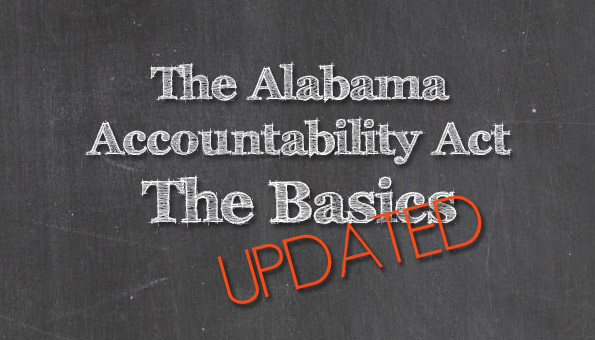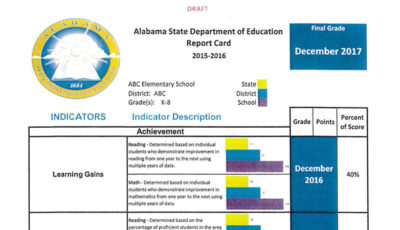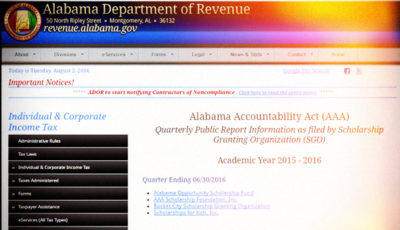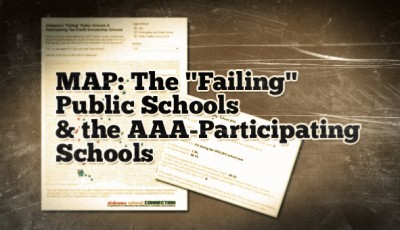The Alabama Accountability Act Basics. UPDATED.
 Big changes were made to the Alabama Accountability Act (AAA) last June. This is the mostest newest-ly* updated information available.
Big changes were made to the Alabama Accountability Act (AAA) last June. This is the mostest newest-ly* updated information available.
First, the big picture.
The AAA is comprised of two major parts: (1) flexibility for public schools and (2) school choice for parents.
Flexibility refers to the ability a school district has to request a waiver from various state (not federal) regulations to better serve the students in their community. According to the Alabama State Department of Education (ALSDE) web site, twenty districts have earned approval for their flexibility waivers.
The school choice made available was initially focused on students zoned for “failing” public schools, but does allow scholarships to be awarded to students not zoned for “failing” public schools.
School choice is made affordable and possible through allowing (1) tax credits to parents who transfer their child away from a “failing” public school and (2) scholarships to students who meet income-eligibility requirements.
Those scholarships are awarded from contributions made by individuals and corporations to a scholarship granting organization (SGO). Donations can be claimed as tax credits as long as certain provisions are met.
Here is an updated version of the Slideshare presentation.
Tax Credit Scholarships
According to the Friedman Foundation for Educational Choice, Alabama is one of four states that has a parent tax credit program, and one of 16 states that has a tax credit scholarship program.
Here is Friedman’s video explanation of a tax credit scholarship program.
The “Failing” Public School
A school that is either designated “failing” by the State Department of Education (ALSDE) or is listed in the lowest six percent of public schools based on the state standardized assessment in reading and math will be labeled “failing” for purposes of the AAA.
The Students
An eligible student is one whose family earns not more than 185% of the federal poverty level (FPL). That level changes from year to year and differs by how many people are in the family. Here are the 2015 numbers. For a family of four, that number is $44,862.50.
Students remain eligible until their family income exceeds 275% of the FPL, which currently is $66,687.50 for that same family of four.
The total amount of the yearly scholarship is capped as follows:
- Elementary school: $6,000
- Middle school: $8,000
- High school: $10,000
The parent of a child zoned to a “failing” public school can request verification of that zoning from the local board of education (BOE), which the local BOE must provide.
All students participating in this program (whether through a parent claiming a tax credit or receipt of a scholarship from an SGO) must take the state achievement test in the grades that students in public schools take the tests. Currently, public school students in grades 3 through 8 take the ACT Aspire.
The SGO must foot the cost of the testing. It is unclear who will pay for testing for students whose parents claim the tax credit (as opposed to receive a scholarship from an SGO).
Test results must be provided to parents.
The Donors
An individual taxpayer can claim 100% of the donation to an SGO as a tax credit, up to 50% of the taxpayer’s liability. The cap was raised to $50,000 per individual taxpayer or married couple filing jointly.
A tax credit can be claimed by an S corporation or a corporation under Subchapter K and passed through to an individual who is a shareholder, partner or member thereof.
A corporation can claim 100% of its donation to an SGO as a tax credit, up to 50% of the corporation’s tax liability. There is no cap for a corporation.
The tax credit can be carried forward for up to three taxable years.
The total cap on donations was raised from $25 to $30 million.
Donations for the 2014 calendar year can be made and tax credits claimed through October 15, 2015. According to the Alabama Department of Revenue, $16 million of the $25 million in tax credits available for 2014 was claimed through October 15, 2015. Verified numbers will not be available until after November 15.
Donations for the 2015 calendar year can also be made and claimed for the entire 2015 calendar year. According to the “My Alabama Taxes” (MAT) site, nearly $14 million of the available $30 million in tax credits had been claimed through November 10.
Donors cannot restrict their donation to either a particular student or a particular school or set of schools and be eligible for the tax credit.
The SGOs
Overall, the SGOs must take more responsibility in many areas, most of which are related to testing and reporting requirements.
SGOs are solely responsible for initially determining a student’s eligibility and making a new determination every other year. No other entity can be charged with making that eligibility determination.
Priority for scholarships must be given to students zoned for “failing” public schools. However, after July 31 of each year, any scholarships funds not accounted for can be awarded to students not zoned for “failing” public schools.
SGOs must ensure that 75% of its first-time scholarship recipients were not enrolled in a nonpublic school during the previous academic year.
SGOs are allowed to utilize and spend up to 5% of contributions in a given calendar year during that year and/or the subsequent calendar year.
Any scholarship funds left over at the end of the academic year following the calendar year in which donor funds are collected must be turned over to the ALSDE for distribution to local boards of education for the benefit of at-risk students.
SGOs are required to ensure that students receiving scholarships conform to the attendance requirements of the school they attend. [The school is required to notify the SGO if a student does not conform to attendance requirements.]
Regarding testing, the SGO must ensure that schools administer the state achievement test or a nationally recognized norm-referenced test to all students receiving educational scholarships from the SGO.
SGOs must collect all of the test results and turn over those results to whomever the Alabama Department of Revenue (ADOR) chooses to analyze those results (more on this farther down the page) by August 1st each year.
The Qualifying Nonpublic Schools
The nonpublic school has three years from the time it is determined to be qualified to subsequently gain accreditation. While they are awaiting accreditation, there are guidelines they must follow.
Those guidelines are:
- Has been in existence for at least three years (see exception below);
- Has daily attendance of at least 85%;
- Has a minimum 180-day school year or the hourly equivalent;
- Has a day length of at least six and one-half hours;
- Requires all students to take the Stanford Achievement Test or its equivalent;
- Requires all candidates for graduation to take the American College Test (ACT) before graduation;
- Requires students in high school in 9th through 12th grade to earn a minimum of 24 credits (each awarded credit must consist of 140 instructional hours);
- Does not subject special education students to the same testing or curricular requirements as regular education students if it is not required in the individual plan for the student;
- Maintains a web site describing the school, instructional program of the school, and the tuition and mandatory fees charged by the school, updated prior to the beginning of each semester.
If a school is not accredited and has not been in existence for three years, it can still become a qualifying school as long as it operates under the governance of a board of directors and meets the other requirements.
If the school does not gain accreditation at the end of the three-year period, it is no longer eligible to receive scholarship funds.
Nonpublic schools can now become qualified if they are accredited by any of the six agencies in the original 2013 version or the National Council for Private School Accreditation, AdvancEd, the American Association of Christian Schools, or one of their partner accrediting agencies.
The school must keeps it web site current and must ensure it is updated prior to the start of each semester to include the current tuition and fees.
If a school is to receive more than $50,000 in scholarship money in an academic year, the school must file a surety bond prior to the first receipt of any funds for that academic year.
By August 1 of each year, the school must submit verification to SGOs that the school complies with the Alabama Child Protection Act of 1999.
In addition, the school must submit verification annually to all SGOs from whom it receives funds that it is complying with health and occupancy laws, nondiscrimination laws, and criminal background checks. The school must also verify it will not employ persons that have been prohibited from working in public school or who may reasonably pose a threat to students.
As noted in the previous section, if a student does not conform to attendance requirements, the school is required to immediately communicate that to the SGO who granted the scholarship.
The SGO Reporting Requirements
Annual reporting has been expanded, and the due date for the annual report (here’s the 2013 report and here’s the page with 2014 and 2015 reports) has changed from June 1 to September 1. This is likely due to the change of reporting year from the calendar year to the academic year (July 1 to June 30).
All of the reports are public.
The annual report, submitted by the SGO, will now include the following information about the previous academic year’s scholarships and recipients:
- the number and dollar amount of contributions received,
- the number and dollar amount of scholarships awarded and funded,
- the number and dollar amount of scholarships awarded and funded for students eligible for free or reduced-price meals, and
- the percent of first-time scholarship recipients who were enrolled in public school during the previous academic year.
New quarterly reports are required to be filed by the SGO. The report must be filed by the 15th day after the end of the calendar year quarter. The quarterly report must include:
- the total number of scholarships awarded and funded,
- the names of the schools that received scholarship money, the total amount paid to the school, and the total number of recipients
- the number of scholarship recipients who were zoned to “failing” public schools, and
- the number of first-time scholarship recipients who were continuously enrolled in nonpublic school during the previous academic year
SGOs must submit verification of the following to ADOR:
- An annual verification that the SGO is determining eligibility,
- An annual verification that the SGO is giving priority for scholarships to students zoned for “failing” public schools,
- An annual verification that the SGO’s policies do not restrict a parent’s educational choice (i.e., that the SGO does not have an exclusive contract with a nonpublic qualifying school to only accept students receiving that SGO’s scholarship funds),
- An annual verification that schools are complying with all laws related to health, occupancy, nondiscrimination and criminal background checks (schools are required to submit that information to the SGOs),
- An annual verification that it has received verification from the school that the school complies with the Alabama Child Protection Act of 1999.
Reporting Test Results
This is something entirely new, and was added in an amendment offered by Representative Terri Collins (R-Decatur).
ADOR must “select an independent research organization, which may be a public or private entity or university,” to analyze and report test results every other year on its web site.
Responding to an inquiry about the independent research organization, ADOR officials said no information is available at this time.
The compiled report will aggregate results by grade level, gender, family income level, number of years of participation in the tax credit scholarship program, and race of the student receiving an educational scholarship. The report will not be specific to any school, but will treat all students as one group.
“The report shall also include, to the extent possible, a comparison of the learning gains of students participating in the tax credit scholarship program to the statewide learning gains of public school students with socioeconomic and educational backgrounds similar to those students participating in the tax credit scholarship program.”
It is unclear how “educational background” will be measured.
The costs of these reports and analyses will be borne by the SGOs in proportion to the contributions received over the two years being measured. SGOs will be allowed to use “funds from outside sources” to pay for its portion of the biennial report.
The first report will be due September 1, 2016. The report must be posted on the ADOR web site.
That’s what we know about the AAA.
Other Resources
The Friedman Foundation for Educational Choice has an easy-to-use web site that states information about various programs fairly simply. Here is their page on the Alabama – Education Scholarship Program.
*We know we used poor grammar. We apologize if we offended anyone. The dizzying pace of change on Alabama’s education landscape makes it difficult to keep up sometimes.





